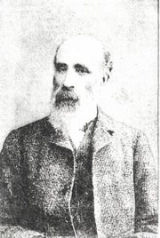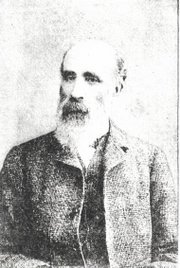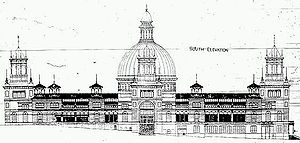
James Barnet
Encyclopedia

New South Wales Government Architect
The New South Wales Government Architect is an officer of the New South Wales government. Historically, the government architect was in charge of the state government's public building projects....
for New South Wales
New South Wales
New South Wales is a state of :Australia, located in the east of the country. It is bordered by Queensland, Victoria and South Australia to the north, south and west respectively. To the east, the state is bordered by the Tasman Sea, which forms part of the Pacific Ocean. New South Wales...
from 1862 - 1890.
Life and career
Barnet was born at Almericlose, ArbroathArbroath
Arbroath or Aberbrothock is a former royal burgh and the largest town in the council area of Angus in Scotland, and has a population of 22,785...
, Scotland
Scotland
Scotland is a country that is part of the United Kingdom. Occupying the northern third of the island of Great Britain, it shares a border with England to the south and is bounded by the North Sea to the east, the Atlantic Ocean to the north and west, and the North Channel and Irish Sea to the...
. The son of a builder, he was educated at the local high school. In 1843, at the age of sixteen, Barnet moved to London, where he became a builder’s apprentice, studying drawing under William Dyce
William Dyce
William Dyce was a distinguished Scottish artist, who played a significant part in the formation of public art education in the UK, as perhaps the true parent of the South Kensington Schools system.Dyce began his career at the Royal Academy schools, and then traveled to Rome for the first time in...
RA
Royal Academy
The Royal Academy of Arts is an art institution based in Burlington House on Piccadilly, London. The Royal Academy of Arts has a unique position in being an independent, privately funded institution led by eminent artists and architects whose purpose is to promote the creation, enjoyment and...
and architecture with CJ Richardson FRIBA
Royal Institute of British Architects
The Royal Institute of British Architects is a professional body for architects primarily in the United Kingdom, but also internationally.-History:...
. He then became of clerk of works with the Worshipful Company of Fishmongers
Worshipful Company of Fishmongers
The Worshipful Company of Fishmongers is one of the 108 Livery Companies of the City of London, being a guild of the sellers of fish and seafood in the City...
. In 1854 he married and sailed for Sydney
Sydney
Sydney is the most populous city in Australia and the state capital of New South Wales. Sydney is located on Australia's south-east coast of the Tasman Sea. As of June 2010, the greater metropolitan area had an approximate population of 4.6 million people...
, Australia
Australia
Australia , officially the Commonwealth of Australia, is a country in the Southern Hemisphere comprising the mainland of the Australian continent, the island of Tasmania, and numerous smaller islands in the Indian and Pacific Oceans. It is the world's sixth-largest country by total area...
, with his new wife, Rosa. In Sydney, he worked first as a builder for Edmund Blacket
Edmund Blacket
Edmund Thomas Blacket was an Australian architect, best known for his designs for the University of Sydney, St. Andrew's Cathedral, Sydney and St...
, then became Clerk of Works at the University of Sydney
University of Sydney
The University of Sydney is a public university located in Sydney, New South Wales. The main campus spreads across the suburbs of Camperdown and Darlington on the southwestern outskirts of the Sydney CBD. Founded in 1850, it is the oldest university in Australia and Oceania...
.
In 1860, he joined the Colonial Architect’s Office
New South Wales Government Architect
The New South Wales Government Architect is an officer of the New South Wales government. Historically, the government architect was in charge of the state government's public building projects....
. In 1862, he was acting head of the office; in 1865, he was promoted to the post of Colonial Architect. He held that position for twenty-five years until the Office was reorganised in 1890.
Major projects for which Barnet was responsible included
- Defence works at Botany Bay, Port JacksonSydney Harbour defencesSydney Harbour was protected by coastal batteries and other fixed defences from the early 19th century until the 1960s. These defences were constructed to protect the Australian city of Sydney from attack by enemy warships and submarines....
and NewcastleNewcastle, New South WalesThe Newcastle metropolitan area is the second most populated area in the Australian state of New South Wales and includes most of the Newcastle and Lake Macquarie Local Government Areas... - Court houses, lock-ups, police stations and post offices throughout New South Wales (see Court houses in New South WalesCourt houses in New South WalesCourt houses in New South Wales were designed by the Colonial Architect, later known as the Government Architect.- Current role :Local Courts in New South Wales have jurisdiction to deal with:* most criminal and summary prosecutions...
) - Lighthouses, including rebuilding the Macquarie LighthouseMacquarie LighthouseThe Macquarie Lighthouse, also known as South Head Upper Light, was the first, and is the longest serving, lighthouse site in Australia. It is located on Dunbar Head, Vaucluse near the entrance to Sydney Harbour. There has been a navigational aid in this vicinity since 1791 and a lighthouse near...
first built by Francis GreenwayFrancis Greenway-References:* *...
, and the similarly designed five lighthouses, Richmond River LightRichmond River LightRichmond River Light, also known as Ballina Head Light and Ballina Light, is an active lighthouse located at Ballina Head, a headland in Ballina, New South Wales, Australia. The headland is at the northern side of the entrance to the Richmond River...
, Clarence River LightClarence River LightClarence River Light, also known as Yamba Light or Clarence Head Light, is an active lighthouse located on Pilot Hill, a hill in Wooli Park, Yamba, New South Wales, Australia, south of the entrance of Clarence River. The current lighthouse was built in 1955, replacing a previous lighthouse built in...
, Tacking Point LighthouseTacking Point LighthouseTacking Point Lighthouse is Australia's third oldest lighthouse. It was built on a rocky headland about 8 kilometres south of Port Macquarie in 1879 by Shepard and Mortley, to a design by the New South Wales government's architect of the time, James Barnet...
, Crowdy Head LightCrowdy Head LightCrowdy Head Light is an active lighthouse located at Crowdy Head, a headland between Forster and Port Macquarie, New South Wales, Australia. It is registered with the Register of the National Estate.-History:...
and Fingal Head LightFingal Head LightFingal Head Light is an active lighthouse located at Fingal Head, New South Wales, Australia, a headland about south of Point Danger, which marks the Queensland border.-History:...
, built in 1878-1880.
Major Sydney public buildings

- New wing of the Australian MuseumAustralian MuseumThe Australian Museum is the oldest museum in Australia, with an international reputation in the fields of natural history and anthropology. It features collections of vertebrate and invertebrate zoology, as well as mineralogy, palaeontology, and anthropology...
- General Post OfficeGeneral Post Office (Sydney)The General Post Office is a landmark building in Sydney, Australia. It is located at the western end of Martin Place , between George and Pitt Streets. The main facade stretches some 100 metres down Martin Place...
- Colonial Secretary's Building (now called the Chief Secretary’s BuildingChief Secretary’s BuildingThe Chief Secretary’s Building is an historic Sydney landmark located at 121 Macquarie Street, 65 Bridge Street and 44-50 Phillip Street....
) - Public Works Building and Lands Building
- Customs HouseCustoms House, SydneyThe Customs House is an historic Sydney landmark located in the city's Circular Quay area. Constructed initially in 1844-1845, the building served as the headquarters of the Customs Service until 1990. Ownership was then transferred from the Commonwealth Government of Australia to the City of...
- Public Library
- Medical School at the University of SydneyUniversity of SydneyThe University of Sydney is a public university located in Sydney, New South Wales. The main campus spreads across the suburbs of Camperdown and Darlington on the southwestern outskirts of the Sydney CBD. Founded in 1850, it is the oldest university in Australia and Oceania...
- Callan Park Lunatic Asylum
- East Sydney Technical College
- Darlinghurst Court House
- Victoria Lodge, Botanical Gardens
- Department of Lands
- Parramatta Post Office
- Traffic Court No.2, Sydney
- North Sydney Post Office (Opened 1889 as St Leonards PO, renamed 1890)
- Mortuary Station, Central Railway
The Colonial Architect’s office was also responsible for maintenance of public buildings. Between 1865 and 1881, Barnet had supervised 1,490 projects. Other roles were assigned to Barnet: for example, he was put in charge of the arrangements for the visit of the Duke of Edinburgh
Alfred, Duke of Saxe-Coburg and Gotha
Alfred, Duke of Saxe-Coburg and Gotha was the third Duke of Saxe-Coburg and Gotha, and reigned from 1893 to 1900. He was also a member of the British Royal Family, the second son and fourth child of Queen Victoria and Prince Albert of Saxe-Coburg and Gotha...
in 1868.

Garden Palace
thumb|300px|Sydney's Garden Palace; an architectural drawing from the 1870s.The Garden Palace was a large purpose-built exhibition building constructed to house the Sydney International Exhibition ...
. The Colonial Architect’s Office completed this large task in nine months, including preparing 412 drawings, management of the accounts and payments associated with the project, and supervision of the building. Night shifts were used to get through the project using the first electric light in Sydney. Although the project was judged a success at the end, Barnet was constantly criticised in Parliament during the construction. The project overran its budget of £50,000 by more than three times, costing £184,570.
Barnet had previously been criticised in 1874 over the new wing of the Australian Museum by the Museum’s trustees and a select committee of the Legislative Assembly. By contrast, also in 1874, his General Post Office in Martin Place received high praise.
From 1870 – 1889 Barnet was on the commission set up to plan the colony’s defence. Barnet built new batteries and barracks. In July 1889, defence works became the responsibility of a military works branch of the Public Works Department. The new director was Lieutenant–Colonel F.R. de Wolski. De Wolski criticised Barnet's work. Barnet was not prompt in handing over plans and documents for defence works. There had been rumours about the project at Bare Island battery in Botany Bay. On 1 July 1890, a Royal Commission was set up to investigate the letting of contracts and report on the work completed. The evidence presented by staff of the Colonial Architect’s office and Barnet was contradictory. The Commission found that the work was below standard and the Colonial Architect’s supervision of the project was not adequate. While the minister supported Barnet, the Commission’s censure was a regrettable end to his distinguished career. Barnet resigned as Colonial Architect. He believed that de Wolski had significantly influenced the Commission and held that the Commission’s findings were unjust, petty and spiteful.
In 1899, Barnet published Architectural work in Sydney, New South Wales, 1788-1899.
Barnet’s work was significantly influenced by the Italian Renaissance. He had little time for the new styles of architecture becoming fashionable in Sydney at the end of the nineteenth century, particularly those that followed American trends. Barnet was also critical of domestic architectural fashions, cluttered with what he saw as useless ornamentation, and “surmounted with blazing red tiles from France.”
Barnet died in 1904 and is buried in the Presbyterian
Presbyterian Church of Australia
The Presbyterian Church of Australia is the largest Presbyterian denomination in Australia. .-Beginnings:...
section of Rookwood Cemetery
Rookwood Cemetery
Rookwood Cemetery is the largest multicultural necropolis in the Southern Hemisphere, located in Sydney, New South Wales, Australia...
. His wife had died in 1890. He was survived by four daughters and three sons, two of whom also practiced as architects.
External links
- Papers held at the University of SydneyUniversity of SydneyThe University of Sydney is a public university located in Sydney, New South Wales. The main campus spreads across the suburbs of Camperdown and Darlington on the southwestern outskirts of the Sydney CBD. Founded in 1850, it is the oldest university in Australia and Oceania...

